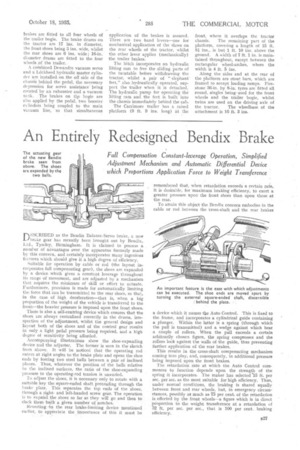An Entirely Redesigned Bendix Brake
Page 41

If you've noticed an error in this article please click here to report it so we can fix it.
Full Compensation Constant-leverage Operation, Simplified Adjustment Mechanism and Automatic Differential Device which Proportions Application Force to Weight Transference
nESCRIBED as the Bendix Balance-Servo brake, a new Li brake gear has recently been brought out by Bendix, Ltd., Tyseley, Birmingham. It is claimed to possess a number Of advantages laver the apparatus formerly made by this concern, and certainly incorporates many ingenious features which should give it a high degree of efficiency.
Suitable for operation by cable or rod (the layout incorporates full compensating gear), the shoes are expanded by a device which gives a constant leverage throughout its range of movement, and are adjusted by a mechanism. that requires the minimum of skill or effort to actuate. Furthermore, provision is made for automatically limiting the force that can be transmitted to the rear shoes, so that, in the case of high deceleration—that is, when a big proportion of the weight of the vehicle is transferred to the front—the heavier pressure is imposed upon the front shoes.
There is also a self-centring device which ensures that the shoes arc always. centralized correctly in the drums, irrespective of the adjustment, whilst the general design and layout both of the shoes and of the control gear results in only a light pedal pressure being required, and a high degree of sensitivity being afforded.
Accompanying illustrations show the shoe-expanding device and the adjuster. The former is seen in the sketch from above. It will be noticed that the operating rod enters at right angles to the brake plate and opens the shoe ends by forcing two steel balls between a pair of inclined planes. Thus, whatever the position of the balls relative to the inclined surfaces, the ratio of the shoe-expanding pressure to the operating-rod tension is unuaried.
To adjust the shoes, it is necessary only to rotate with a suitable key the square-ended shaft protruding through the brake plate. This separates the top ends of the shoes, through a rightand left-handed screw gear. The operation is to expand the shoes so far as they. will go and then to slack them back a given number of notches.
Reverting to the rear brake-limiting device mentioned earlier, to appreciate the ,importance of this it must be remembered that, when retardation exceeds a certain raie, it is desirable, for maximum braking efficiency, to exert a greater pressure upon the front shoes than upon those at the rear.
To attain this object the Bendix concern embodies in the cable or rod between the cross-shaft and the rear brakes a device which it names the Auto Control. This is fixed to the frame, and incorporates a cylindrical guide containing a plunger. Within the latter is a spring (through which the pull is transmitted) and a wedge against which bear a couple of rollers. When the pull exceeds a certain arbitrarily chosen figure, the spring compresses and the rollers lock against the walls of the guide, thus preventing further application of the rear brakes.
This results in the cross-shaft compensating mechanism coming into play, and, consequently, in additional pressure being imposed upon the front brakes.
The retardation rate at which the Auto Control commences to function depends upon the strength of the spring it incorporates. The maker has selected '15 ft. per sec. per sec. as the most suitable for high efficiency. Thus, under normal conditions, the braking is shared equally between front and rear wheels, but, in emergency circumstances, possibly as much as 75 per cent. of the retardation is effected by the front wheels—a figure which is in direct proportion to the weight transference at a retardation of 32 ft. per sec. per sec., that is 100 per cent. braking efficiency.




























































































